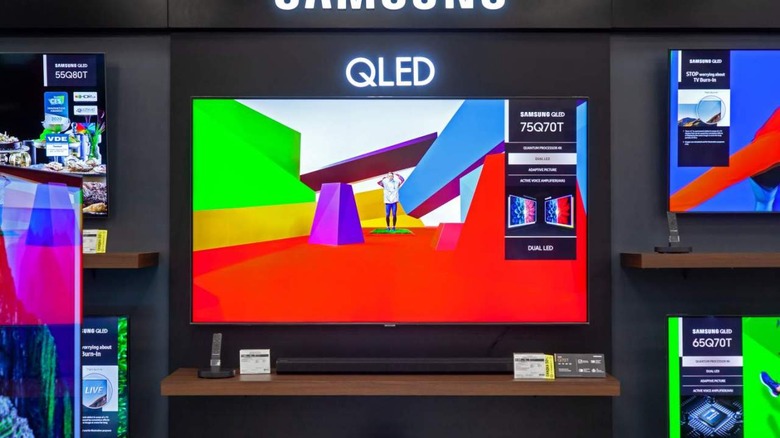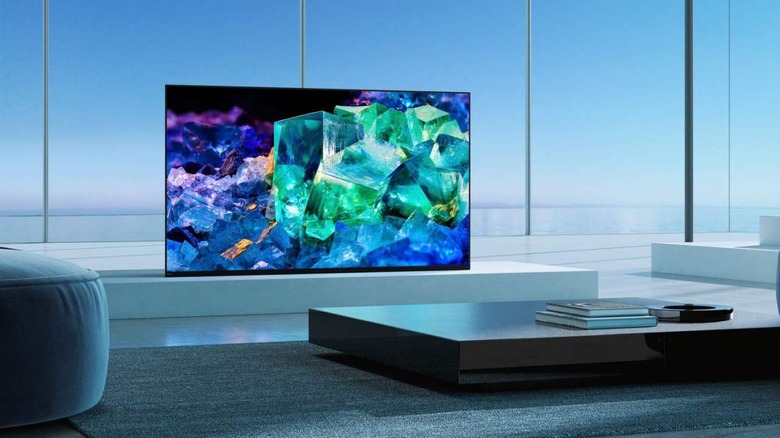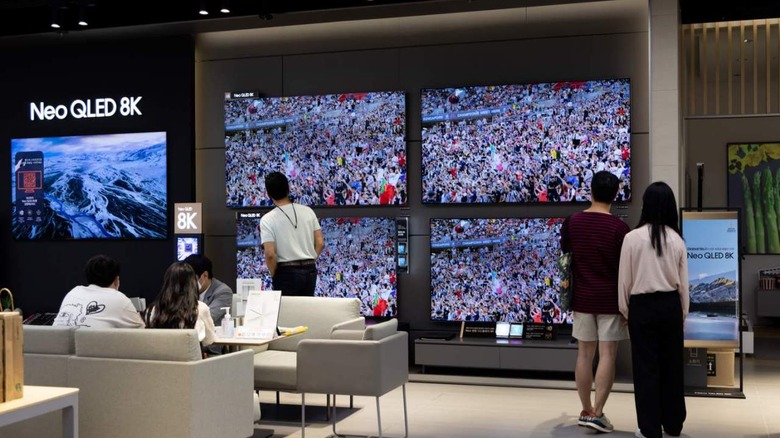The Differences Between OLED And QLED TVs Explained
We may receive a commission on purchases made from links.
Shopping for a new TV can be a bewildering affair with so many different choices on the market. Two of the most popular types of TVs are OLED and QLED TVs. Although they might appear to be similar based on their names, they are quite different technologies. Both have their respective advantages and disadvantages and generally traverse similar price points, but before you drop your hard-earned money on one or the other, it is a good idea to get familiar with what each offers.
We'll start with OLED TVs, which is a term some are familiar with from their smartphones. OLED panels replaced LCDs (Liquid Crystal Displays) on many smartphones and were vaunted because of their bright colors which contrasted nicely with dark blacks. This is also a characteristic that makes OLED TVs a popular choice. OLED display panels are able to achieve these qualities because the pixels in the display are self-lit instead of having an LED backlight like an LCD panel.
This means that any pixels that are not required to produce a color can remain switched off, leaving a pure black behind. This delivers excellent contrast to any pixels that are lit, or switched on, whereas LCD blacks can look a little gray or washed out because of the need for backlighting. Because of this, the main drawback of OLED panels is a comparative lack of brightness.
QLED TVs can offer better longevity
QLED TVs are, at their most basic level, just like traditional LCD TVs in that they combine a liquid crystal layer with an LED backlighting system. This means that they don't produce quite the same level of dramatic contrast between the colors being shown and standard blacks.
However, to help offset this, they add what is known as a quantum dot layer (the Q in QLED) to the panel that helps to produce much more vivid colors than a regular LCD display. They are also typically much brighter than an OLED panel, making them just as visually striking in many ways while also offering a longer lifespan. Over time, OLED panels can start to wear out with the blue colors prone to degrading faster than the red and green colors. This can lead to what's known as "burn-in."
As you will no doubt be aware, major TV manufacturers are releasing new models of TVs on an annual basis. In fact, either late in the year or early in the new year is often a good time to buy a new TV as the introduction of the new models often means good deals on the old models. However, the rate of technological advancement in OLED and QLED TVs is quite rapid and improvements to older technologies are constantly being made while new technologies are also being introduced.
Quantum Dot is no longer just for QLED TVs
As we mentioned earlier, OLED panels are typically not as bright as QLED panels. To help mitigate this deficiency and better compete with QLED panels, some recent OLED TVs are now also adding a quantum dot layer to their designs. This new hybrid design has the same effect that quantum dot layers have on QLED TVs, which is to make colors more vivid and also brighter.
However, as QD OLED panels are self-lit and don't have a dedicated layer of white LEDs behind them, peak brightness won't be quite in the same league as QLED TVs. Overall, these should still be a significant step forward with the addition of new white sub-pixels and a blue self-luminescent layer.
Leading QLED TV makers are adding Mini LED backlighting for better local area dimming performance. Apple made headlines when it added Mini LED backlighting to its 12.9-inch iPad Pro and new 14-inch and 16-inch MacBook Pro models. However, Apple's new displays continue to otherwise use regular LCD technology with quantum dot technology absent.
Just as with Apple's new displays, QLED panels with mini-LED backlighting have a greater number of areas that can have their brightness dimmed in order to improve contrast with nearby pixels lit up in colors. This helps these new QLED panels better compete with OLED panels, although much improved, the contrast still doesn't quite match OLED panels.
Wrap-up
It's never been a better time to shop for a new OLED or QLED TV. There are many major manufacturers making either OLED or QLED TVs with some now even offering a choice of both. As we've highlighted, both display technologies have their respective strengths and weaknesses, some of which have been offset with the latest advancements in both camps.
As with most things in life, you get what you pay for which means TVs at the lower end of the price spectrum for either OLED or QLED TVs won't produce the same level of image quality as the more expensive models.
As CNET explains, even entry-level OLED and QLED TVs often produce better results than pricier LCD TVs from only a few years ago. Remember to look for a good deal on superseded models — although they might not have all the very latest features, they often represent a good buy for the money. The choice, in the end, is yours.



